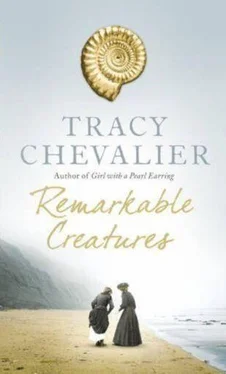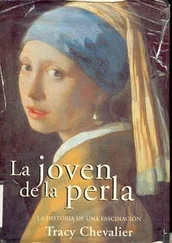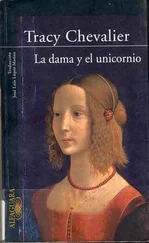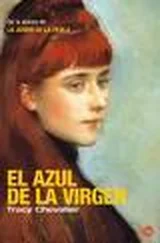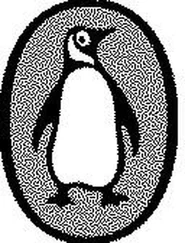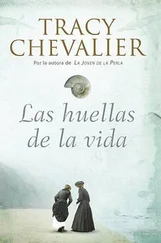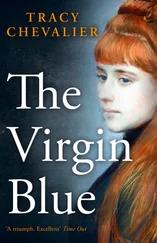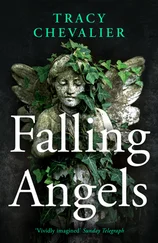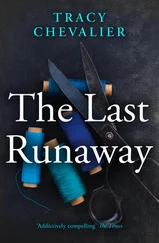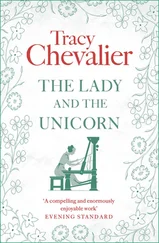So we continued, arm in arm along the beach, talking until at last we had no more to say, like a storm that blows itself out, and our eyes dropped to the ground, where the curies were waiting for us to find them.
Mary Anning and I are hunting fossils on the beach, she her creatures, I my fish. Our eyes are fastened to the sand and rocks as we make our way along the shore at different paces, first one in front, then the other. Mary stops to split open a nodule and find what may be lodged within. I dig through clay, searching for something new and miraculous. We say very little, for we do not need to. We are silent together, each in her own world, knowing the other is just at her back.
Postscript.
The reader’s patience
Mary Anning’s name was first published in a scientific context in France in 1825, when Georges Cuvier added it to a caption for an illustration of a plesiosaur specimen, in the third edition of his book Discours sur les révolutions de la surface du globe (Discourse on the revolutionary upheavals on the surface of the earth). She was first mentioned by name in Great Britain in a paper by William Buckland on coprolites in 1829; by then she and Buckland had worked out that bezoar stones were the faeces of ichthyosaurs and plesiosaurs. She also discovered the first complete pterodactyl (now called a pterosaur) in Great Britain, and the squaloraja, a transition animal between sharks and rays, which became a type specimen.
Mary Anning never married, living with her mother until Molly’s death in 1842. They moved from Cockmoile Square to a house with a shop front on Broad Street in 1826. Mary’s dog Tray was killed in a landslip in 1833; it missed Mary by a few feet. Mary died of breast cancer in 1847 at the age of forty-seven. She is buried in the church yard of St Michael’s, which she joined later in life. Her ichthyosaurs and plesiosaurs are on display at the Natural History Museum in London, and the headless plesiosaur Cuvier bought from her is on display in the Palaeontology Gallery of the Musée National d’Histoire Naturelle in Paris.
In 1834 the Swiss scientist Louis Agassiz came to Lyme and studied Elizabeth Philpot’s fossil fish collection. He thanked both Elizabeth and Mary Anning in his book Recherches sur les poissons fossils (Research on Fossil Fish) and named fish species after both of them. Elizabeth outlived both Mary Anning and her sisters, dying in 1857 at the age of seventy-eight. Her nephew John inherited her estate, and in 1880 his wife donated the Philpot fossil collection to the Oxford University Museum of Natural History, where there are still drawers full of her superb specimens. Elizabeth ’s great nephew Thomas later established the Philpot Museum in Lyme Regis. Rather fittingly, the museum is now housed in a handsome building on the site of the Annings’ house in Cockmoile Square, where amongst many treasures concerning the town’s history you can see on display the fossil hammer Mary’s father made for her.
Joseph Anning became a full-time upholsterer in 1825, married in 1829, and had three children. Apparently Mary Anning did not get on with his wife. Joseph managed to achieve the respectable life he craved, overseeing parish relief and becoming a church warden.
Colonel Thomas James Birch became Thomas James Bosvile in 1824, when he inherited the title and the family estate in Yorkshire. He died in 1829.
William Buckland did find a woman to marry him, in 1825-she was sitting opposite him in a coach and reading a volume of Cuvier. He continued to eat his way through the animal kingdom, and to try to reconcile geology with his religious beliefs. He later became Dean of Westminster School, but towards the end of his life he suffered from mental illness and had to be placed in an asylum.
Between 1830 and 1833 Charles Lyell published Principles of Geology, which became the seminal text on modern geology; Charles Darwin took it with him on his famous voyage on the Beagle.
Jane Austen visited Lyme in September 1804, and there is no reason why she and Margaret Philpot could not have been in the Assembly Rooms at the same time. Indeed, she did meet Richard Anning, for she went to his shop to have him give her a quote on fixing the broken lid of a chest. According to a letter she wrote to her sister, he charged far too much, and she took her business elsewhere.
Remarkable Creatures is a work of fiction, but many of the people existed, and events such as Colonel Birch’s auction and the Geological Society meeting where Conybeare talked about the plesiosaur did take place. And Mary did indeed write at the bottom of a scientific paper she had copied out: “When I write a paper there shall not be but one preface.” Sadly she never did write her own scientific paper.
Twenty-first-century attitudes towards time and our expectations of story are very different from the shape of Mary Anning’s life. She spent day after day, year after year, doing the same thing on the beach. I have taken the events of her life and condensed them to fit into a narrative that is not stretched beyond the reader’s patience. Hence events, while in order, do not always coincide exactly with actual dates and time spans. Plus, of course, I made up plenty. For instance, while there was gossip about Mary and Buckland and Mary and Birch, there was no proof. That is where only a novelist can step in.
I would like to thank the following: the staff of the libraries at the Geological Society and the Natural History Museum, London; the staff of the Lyme Regis Philpot Museum, the Dorset County Museum and the Dorset History Centre in Dorchester; the Dinosaur Museum, Dorchester, where I first learned of Mary Anning; Philippe Taquet of the Musée National d’Histoire Naturelle, Paris; Paul Jeffery at the Oxford University Museum of Natural History; Maureen Stollery for her help with Philpot genealogy; Alexandria Lawrence; Jonny Geller; Deborah Schneider; Susan Watt; Carole DeSanti; and Jonathan Drori.
Most of all, I would like to thank three people: Hugh Torrens, who knows more about Mary Anning than anyone and has been very cordial to me. Jo Draper, who is a saint, opening up the files at the Philpot Museum and sending me bits and pieces of information about everything, and who wears her erudition lightly and with great humour. Finally, Paddy Howe, fossil hunter extraordinaire, who gave me many fossils and took me to the beach between Lyme and Charmouth to find more, teaching me with patience, intelligence, and grace.
Deborah Cadbury, The Dinosaur Hunters: A True Story of scientific Rivalry and the Discovery of the Prehistoric World, 2000 (UK); as Terrible Lizard: The First Dinosaur Hunters and the Birth of a New Science, 2001 (US)
William Conybeare and Henry De La Beche, papers on the ichthyosaur and plesiosaur for the Geological Society, 1821, 1822, 1824, reprinted in The Dinosaur Papers, 1676-1906, edited by David B. Weishampel and Nadine M. White, 2004
Jo Draper, Mary Anning’s Town: Lyme Regis, 2004
John Fowles, A Short History of Lyme Regis, 1991
Charles C. Gillispie, Genesis and Geology: A Study in the Relations of scientific Thought, Natural Theology, and Social Opinion in Great Britain, 1790-1850, 1951
S.R. Howe, T. Sharpe and H.S. Torrens, Ichthyosaurs: A History of Fossil “Sea-Dragons”, 1981
W.D. Lang, various papers on Mary Anning in the Proceedings of the Dorset Natural History and Archaeological Society, 1936-1963
Christopher McGowan, The Dragon Seekers: The Discovery of Dinosaurs During the Prelude to Darwin, 2001
Judith Pascoe, chapter on Mary Anning in The Hummingbird Cabinet: A Rare and Curious History of Romantic Collectors, 2005
Patricia Pierce, Jurassic Mary: Mary Anning and the Primeval Monsters, 2006
Читать дальше
Конец ознакомительного отрывка
Купить книгу
